nasa
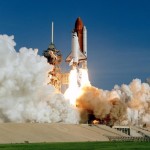 September 17, 1976 was an epic day in American history, and truly in world history as well. This was the day that the seemingly impossible became possible. Man had been in space many times by that date, but the crafts taken were disposable, and the cost to build new ones was great. It would be an amazing thing to have a craft that could take man into space, and then make a smooth landing back on Earth. It was unheard of, but it was no longer impossible.
September 17, 1976 was an epic day in American history, and truly in world history as well. This was the day that the seemingly impossible became possible. Man had been in space many times by that date, but the crafts taken were disposable, and the cost to build new ones was great. It would be an amazing thing to have a craft that could take man into space, and then make a smooth landing back on Earth. It was unheard of, but it was no longer impossible.
On this day in 1976, NASA publicly unveiled its first space shuttle. The shuttle was called Enterprise, and during a ceremony in Palmdale, California, the world got its first glimpse of the future. The Space Shuttle looked like an airplane. Its development cost almost $10 billion and took nearly a decade. The shuttle would not actually fly until 1977. Enterprise became the first space shuttle to fly freely when it was lifted to a height of 25,000 feet by a Boeing 747 airplane and then released, gliding back to Edwards Air Force Base on its own accord. It was a phenomenal accomplishment. What an exciting event in NASA history!!
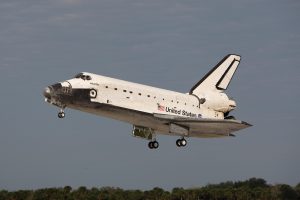
With the success of the first flight, came regular flights of the space shuttle, which began on April 12, 1981, with the launching of Columbia from Cape Canaveral, Florida. The shuttle had to be able to get into space, and so it was launched by two solid-rocket boosters and an external tank. These were ejected prior to the actual entrance into space, and only the shuttle, which looked like an actual airplane, entered into orbit around Earth. When the two-day mission was completed, the shuttle fired its engines to reduce speed and, after descending through the atmosphere, landed like a glider at California’s Air Force Base…brought to a stop with the help of three parachutes.
Early shuttles took satellite equipment into space and carried out various scientific experiments. On January 28, 1986, NASA and the space shuttle program suffered a major setback when the Challenger exploded 74 seconds after takeoff and all seven people aboard were killed. That was a horrible day in shuttle history. After changing the things that caused the problem, the shuttle flew again beginning in September 1988, when Discovery went up successfully. Since 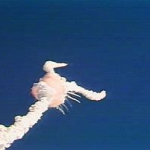 then, the space shuttle has carried out numerous important missions, such as the repair and maintenance of the Hubble Space Telescope and the construction and manning of the International Space Station. A tragedy in space again rocked the nation on February 1, 2003, when Columbia, on its 28th mission, disintegrated during re-entry of the earth’s atmosphere. All seven astronauts aboard were killed. In the aftermath, the space-shuttle program was grounded until Discovery returned to space in July 2005, amid concerns that the problems that had downed Columbia had not yet been fully solved. On July 21, 2011, Space Shuttle Atlantis touched down for the final time, at the end of STS-135, with the official retirement of NASA’s Space Shuttle fleet taking place from March to July 2011.
then, the space shuttle has carried out numerous important missions, such as the repair and maintenance of the Hubble Space Telescope and the construction and manning of the International Space Station. A tragedy in space again rocked the nation on February 1, 2003, when Columbia, on its 28th mission, disintegrated during re-entry of the earth’s atmosphere. All seven astronauts aboard were killed. In the aftermath, the space-shuttle program was grounded until Discovery returned to space in July 2005, amid concerns that the problems that had downed Columbia had not yet been fully solved. On July 21, 2011, Space Shuttle Atlantis touched down for the final time, at the end of STS-135, with the official retirement of NASA’s Space Shuttle fleet taking place from March to July 2011.
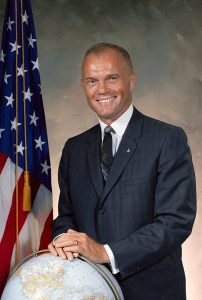
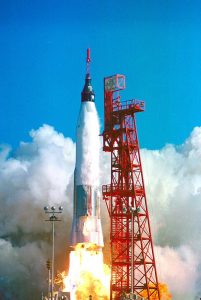 I’m sure that many of you remember the movie, Deep Impact, which was about a group of astronauts trying to save the world by deflecting a meteor, so it wouldn’t hit the earth. Robert Duvall played the part of Captain Spurgeon “Fish” Tanner, a retired, and largely considered by the rest of the crew, an “over the hill” astronaut. Nevertheless, in the end, they were glad they had him when it came to completing their mission, even though it did cost them their lives. Of course, the movie was fictional, and not realistic in many aspects, but the part that struck me as cool, was that the retired astronaut got a second chance to be useful in an important mission.
I’m sure that many of you remember the movie, Deep Impact, which was about a group of astronauts trying to save the world by deflecting a meteor, so it wouldn’t hit the earth. Robert Duvall played the part of Captain Spurgeon “Fish” Tanner, a retired, and largely considered by the rest of the crew, an “over the hill” astronaut. Nevertheless, in the end, they were glad they had him when it came to completing their mission, even though it did cost them their lives. Of course, the movie was fictional, and not realistic in many aspects, but the part that struck me as cool, was that the retired astronaut got a second chance to be useful in an important mission.
However, Captain Spurgeon Tanner wasn’t the only retired astronaut to get a second chance to go into space. On October 29, 1998, nearly four decades after he became the first American to orbit the Earth, Senator John Hershel Glenn Jr was launched into space again as a payload specialist aboard the space shuttle Discovery. At 77 years of age, Glenn was the oldest human ever to travel in space. During the nine day mission, he served as part of a NASA study on health problems associated with aging. Like our fictional Captain Spurgeon Tanner, Senator John Glenn was useful in space again. He had something that the other astronauts didn’t have…age. I don’t suppose that the studies done on John Glenn were the saving the world type, but they were real life studies, and that’s important too.
John Glenn became famous when he was chosen by NASA in 1959, along with six other men, to be the first American astronauts. He was a lieutenant colonel in the US Marine Corps. A decorated pilot, he flew nearly 150 combat missions during World War II and the Korean War. In 1957, he made the first nonstop supersonic flight across the United States, flying from Los Angeles to New York in three hours and 23 minutes. Then, in April 1961, the American space program suffered a setback of sorts, when Soviet cosmonaut Yuri Gagarin became the first man in space, and his spacecraft, Vostok 1, made a full orbit before returning to Earth. It was a feat that the United States had hoped to achieve first. The United States kicked things into high gear, and less than one month later, American Alan Shepard Jr became the first American in space when his Freedom 7 spacecraft was launched on a suborbital flight. American “Gus” Grissom made another suborbital flight in July. Then, in August, Soviet cosmonaut Gherman Titov spent more than 25 hours in space aboard Vostok 2, making 17 orbits. As a technological power, the United States looked second-rate, compared with its Cold War adversary.
If the Americans wanted to dispel this notion, they needed a multi-orbital flight before another Soviet space advance arrived. On February 20, 1962, NASA and Colonel John Glenn accomplished this feat with the flight of Friendship 7, a spacecraft that made three orbits of the Earth in five hours. Glenn was hailed as a national hero, and on February 23 President John F. Kennedy visited him at Cape Canaveral. Glenn later addressed Congress and was given a ticker-tape parade in New York City. It was at this point that NASA made the unfortunate decision not to risk the life of the now famous Glenn by sending him into space again. NASA essentially grounded the “Clean Marine” in the years after his historic flight. Frustrated with this uncharacteristic lack of activity, Glenn turned to politics, In 1964, he announced his candidacy for the US Senate from his home state of Ohio and formally left NASA. Later that year, however, he withdrew his Senate bid after seriously injuring his inner ear in a fall from a horse. In 1970, following a stint as a Royal Crown Cola executive, he ran for the Senate again but lost the Democratic nomination to Howard Metzenbaum. Four years later, he defeated Metzenbaum, won the general election, and went on to win re-election three times. In 1984, he unsuccessfully sought the Democratic nomination for president.

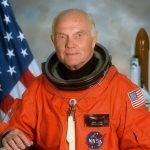
His really big claim to fame would once again come from NASA, which seemed to be his destiny after all. In 1998, Glenn attracted considerable media attention when he returned to space aboard the space shuttle Discovery. In 1999, he retired from his US Senate seat after four consecutive terms in office, a record for the state of Ohio. While his years in politics were much longer, he will always be remembered for the two historic flights he made into space.
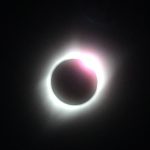
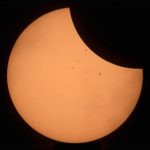 With yesterday’s eclipse, came a massive amount of videos and photos documenting the event. Before it was even over, people all over the world were able to view the event. NASA filmed it and posted it on their website…including the moments when the International Space Station flew in front of it!! It was an awesome way for people, who were unable to get to the path of totality, to view the event. While we give little thought to such abilities today, just a few years back, they would have seemed impossible, or at the very least, they would have shocked us. That’s because we have things like television, internet, cell phones, and digital cameras…but they didn’t then. The television was looked upon as a fad that would never take hold. People simply wouldn’t spend the money on one. How very wrong they were.
With yesterday’s eclipse, came a massive amount of videos and photos documenting the event. Before it was even over, people all over the world were able to view the event. NASA filmed it and posted it on their website…including the moments when the International Space Station flew in front of it!! It was an awesome way for people, who were unable to get to the path of totality, to view the event. While we give little thought to such abilities today, just a few years back, they would have seemed impossible, or at the very least, they would have shocked us. That’s because we have things like television, internet, cell phones, and digital cameras…but they didn’t then. The television was looked upon as a fad that would never take hold. People simply wouldn’t spend the money on one. How very wrong they were.
Lets travel back in time to when television first came out. All the people had were radios to hear about the things that were going on…or the newspapers. There was simply no way to show the people what an eclipse looked like, unless they saw it for themselves. No way to warn them of the serious dangers of looking at it. Things like that were by trial and error. Not only that, but they really couldn’t predict and eclipse. And space travel…what was that? Nevertheless, the dawning of a new age was upon them. The days of being in the dark when it came to world events was about to end. And television would bring with it so much more than just the news. Still, the television, when it first made its appearance on the planet, cost a lot of money. Far to much money for the average family to spend on the new fangled contraption, so few people had one. That didn’t stop the kids, and even adults, from watching it in the store windows, they just didn’t get to watch it very often.
As time went by, the prices of televisions came down, and people realized that this wasn’t just a passing fad. 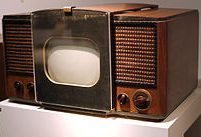
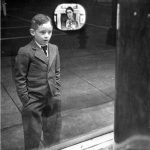 These days, nearly every household in the United States, if not the world has one, and those who don’t, have likely chosen to walk away from the television. And we aren’t even tied to our homes to watch television now. We can watch it from our computers or even our cell phones. Wow!! How far we have come. News is only new for a few seconds, and by the time stories come out in the paper, they have already been read on the internet. Before long, I’m sure the newspaper will become obsolete…if it hasn’t already.
These days, nearly every household in the United States, if not the world has one, and those who don’t, have likely chosen to walk away from the television. And we aren’t even tied to our homes to watch television now. We can watch it from our computers or even our cell phones. Wow!! How far we have come. News is only new for a few seconds, and by the time stories come out in the paper, they have already been read on the internet. Before long, I’m sure the newspaper will become obsolete…if it hasn’t already.
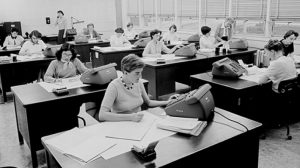 When we think of computers, most of us think of the modern day laptop, or even our smart phones, and when we think of who invented the computer, we think of a man, and that would probably be right, but when NASA thinks of computers, they also have to include the Women of NASA. They were known as “human computers” long before desktop, laptops, or even multi-function calculators existed. Barbara “Barby” Canright joined California’s Jet Propulsion Laboratory in 1939. She was the first female “human computer” and her job was to calculate anything from how many rockets were needed to make a plane airborne to what kind of rocket propellants were needed to propel a spacecraft. She did her calculations by hand, with only a pencil and graph paper. It often took more than a week to complete, and her work commonly filled six to eight notebooks with data and formulas. After the Japanese attack on Pearl Harbor, her work, along with that of her mostly male teammates, took on a new meaning. There was important work to be done to secure the safety of our nation. The army needed to lift a 14,000 pound bomber into the air, and Barby was responsible for determining the thrust-to-weight ratio and comparing the performance of engines under various conditions, so they could make that happen. Due to the amount of work it was going to take to accomplish this task, more “computers” were hired, including three women Melba Nea, Virginia Prettyman and Macie Roberts.
When we think of computers, most of us think of the modern day laptop, or even our smart phones, and when we think of who invented the computer, we think of a man, and that would probably be right, but when NASA thinks of computers, they also have to include the Women of NASA. They were known as “human computers” long before desktop, laptops, or even multi-function calculators existed. Barbara “Barby” Canright joined California’s Jet Propulsion Laboratory in 1939. She was the first female “human computer” and her job was to calculate anything from how many rockets were needed to make a plane airborne to what kind of rocket propellants were needed to propel a spacecraft. She did her calculations by hand, with only a pencil and graph paper. It often took more than a week to complete, and her work commonly filled six to eight notebooks with data and formulas. After the Japanese attack on Pearl Harbor, her work, along with that of her mostly male teammates, took on a new meaning. There was important work to be done to secure the safety of our nation. The army needed to lift a 14,000 pound bomber into the air, and Barby was responsible for determining the thrust-to-weight ratio and comparing the performance of engines under various conditions, so they could make that happen. Due to the amount of work it was going to take to accomplish this task, more “computers” were hired, including three women Melba Nea, Virginia Prettyman and Macie Roberts.
It was a time when women were mostly homemakers, and in fact, often looked at as probably not able to understand complicated things like math, science, and engineering, but times were changing. We were a nation at war, and many of the men were fighting. Not only did the women step up to the plate, but they showed that they could understand the work they did, as well as, if not better than their male counterparts. In fact, they did their work so well, that their calculations would end up charting the course of many ground breaking missions that would carry United States astronauts to the moon and beyond. These women were an elite team of mathematicians, engineers and scientists, who were tasked with turning numbers into meaningful data at what would later become NASA’s Jet Propulsion Laboratory and Langley Research Center. They challenged NASA to let them show what they could do, and when NASA did so, they really shined. It was an eye-opening accomplishment, and one that I’m pretty sure many men thought couldn’t be done.
It’s a funny thing, in my mind, that they were called “human computers” though. I suppose the work they did was computing, but the terminology just seems odd. These days, we talk about someone having the mind of a computer, but we don’t call them a computer. I guess that’s because we have computers, and no one would think of a person in that way. The reality is that, while these women were breaking ground in previously uncharted territory, their services would never really become unnecessary. In fact, one of the earliest human computers still works at Jet Propulsion Laboratory. Sue Finley is 80 now, and NASA’s longest serving female employee. She was originally hired in 1958 to work on trajectory computations for rocket launches, and is now  a software tester and subsystem engineer. She is currently working on NASA’s mission to Jupiter. Her legacy, and that of the other early human computers, is literally written in the stars. What really amazes me is that many people over 70 have no idea how to work a computer, and yet here is this 80 year old woman who is a software tester and subsystem engineer. Amazing!! Totally amazing!!
a software tester and subsystem engineer. She is currently working on NASA’s mission to Jupiter. Her legacy, and that of the other early human computers, is literally written in the stars. What really amazes me is that many people over 70 have no idea how to work a computer, and yet here is this 80 year old woman who is a software tester and subsystem engineer. Amazing!! Totally amazing!!
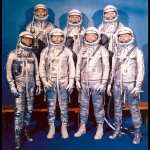 The year was 1959, and things were changing rapidly in the world of flight. Airplanes had been around, and actually flying since the December 17, 1903 flight of the Kitty Hawk by the Wright brothers. Air travel, while not as common as it is today, was fairly common. Now, it was time for the next step. We had looked through telescopes, found the planets, their moons, and other suns. We discovered galaxies beyond our own, and then, someone…somewhere, decided that it was time for mankind to go out there and have a look for ourselves.
The year was 1959, and things were changing rapidly in the world of flight. Airplanes had been around, and actually flying since the December 17, 1903 flight of the Kitty Hawk by the Wright brothers. Air travel, while not as common as it is today, was fairly common. Now, it was time for the next step. We had looked through telescopes, found the planets, their moons, and other suns. We discovered galaxies beyond our own, and then, someone…somewhere, decided that it was time for mankind to go out there and have a look for ourselves.
By late 1958 plans were well underway to take that first step. Seven men were picked, and on this day April 9, 1959 NASA announced that they had decided on the first seven astronauts, who would take that very first space flight. The men were dubbed The Mercury Seven, but were also called the Original Seven or Astronaut Group 1. The men were Scott Carpenter, Gordon Cooper, John Glenn, Gus Grissom, Wally Schirra, Alan Shepard, and Deke Slayton. They piloted the manned spaceflights of the Mercury program from May 1961 to May 1963. They weren’t the first men in space, but they were the first from the United States. The first human to journey into outer space, was Yuri Gagarin, when his Vostok spacecraft completed an orbit of the Earth on 12 April 1961. Alan Shepard became the first American in space 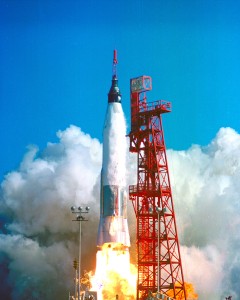 when the Freedom 7 spacecraft blasted off from Florida on May 5, 1961, just under a month after the Russian flight. Ten years later, Shepard would fly again to become the fifth man to walk on the moon…and the first to play golf there.
when the Freedom 7 spacecraft blasted off from Florida on May 5, 1961, just under a month after the Russian flight. Ten years later, Shepard would fly again to become the fifth man to walk on the moon…and the first to play golf there.
Most of these seven men went on to fly in many successful missions, with Gus Grissom being the only one to die young and on duty with NASA, in the Apollo 1 fire. Members of the group flew on all classes of NASA manned orbital spacecraft of the 20th century…Mercury, Gemini, Apollo, and the Space Shuttle. John Glenn, the oldest, is the only one who is still living. He went on to become a United States senator, and flew on the Shuttle 36 years later to become the oldest person to fly in space. The others all survived past retirement from service. These men played a key part in the world as we know it today, because space travel has played a key part in many of our modern medicines and scientific research. And it all began on this day in 1959.
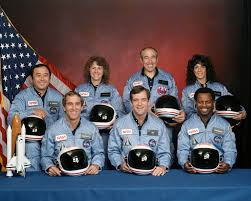 Inspiration comes from many different places, but most often from an event that so strongly affects our emotions or our lives, that we feel the need to act. That is what happened to a number of students who all had something in common…Christa McAuliffe. On this day, January 28, 1986…30 years ago, after months of training and a huge national following, Christa McAuliffe entered the Space Shuttle Challenger, and went down in history as not only the first teacher chosen to go into space, but the first civilian to die on such a mission. She never made it into space, because just 73 seconds after the launch, the Challenger exploded.
Inspiration comes from many different places, but most often from an event that so strongly affects our emotions or our lives, that we feel the need to act. That is what happened to a number of students who all had something in common…Christa McAuliffe. On this day, January 28, 1986…30 years ago, after months of training and a huge national following, Christa McAuliffe entered the Space Shuttle Challenger, and went down in history as not only the first teacher chosen to go into space, but the first civilian to die on such a mission. She never made it into space, because just 73 seconds after the launch, the Challenger exploded.
The world looked on in horror, because this launch had been so widely televised and so greatly anticipated. 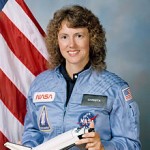 After the explosion, the news was broadcast over and over. We saw the horrified faces of the families of the crew, the tears of family, friends, and students of the first teacher in space, and we saw the explosion…over and over again. The heart of a nation was broken, not just because of Christa McAuliffe, but also for the families of payload specialist Gregory Jarvis; and astronauts Judith A. Resnik, mission specialist; Francis R. (Dick) Scobee, mission commander; Ronald E. McNair, mission specialist; Mike J. Smith, pilot; and Ellison S. Onizuka, mission specialist. It had been many years since the NASA space program had lost a crew, and it was the first one in flight.
After the explosion, the news was broadcast over and over. We saw the horrified faces of the families of the crew, the tears of family, friends, and students of the first teacher in space, and we saw the explosion…over and over again. The heart of a nation was broken, not just because of Christa McAuliffe, but also for the families of payload specialist Gregory Jarvis; and astronauts Judith A. Resnik, mission specialist; Francis R. (Dick) Scobee, mission commander; Ronald E. McNair, mission specialist; Mike J. Smith, pilot; and Ellison S. Onizuka, mission specialist. It had been many years since the NASA space program had lost a crew, and it was the first one in flight.
I’m sure that an accident in space did not inspire people to go into the space program, because the safety of the program immediately came into question. Nevertheless, from this tragedy…from out of the ashes of the Space Shuttle Challenger, inspiration did come. It came in the form of teachers. The students of Christa 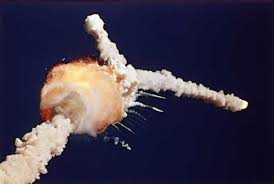 McAuliffe…not all, but a number of them, were inspired to become teachers themselves. Each of those former students of Christa McAuliffe…kids who maybe didn’t like social studies, but because Christa McAuliffe made it interesting somehow, they did well in her class, and were inspired by her. After her passing, these inspired students decided that they wanted to pick up where she left off. They wanted to carry on with her dream. They follow her motto, “I touch the future. I teach.” One of those teachers commented that she heard people say that and wondered if they had any idea where that motto came from. Her former students knew…it was Christa McAuliffe, and her legacy lives on, 30 years after her death.
McAuliffe…not all, but a number of them, were inspired to become teachers themselves. Each of those former students of Christa McAuliffe…kids who maybe didn’t like social studies, but because Christa McAuliffe made it interesting somehow, they did well in her class, and were inspired by her. After her passing, these inspired students decided that they wanted to pick up where she left off. They wanted to carry on with her dream. They follow her motto, “I touch the future. I teach.” One of those teachers commented that she heard people say that and wondered if they had any idea where that motto came from. Her former students knew…it was Christa McAuliffe, and her legacy lives on, 30 years after her death.
 After a horrific accident such as Space Shuttle Challenger’s explosion 73 seconds after liftoff on January 28, 1986, taking with it seven astronauts, it is only prudent for NASA to have stopped all future flights until they knew the cause and had a fix in place. The Space Shuttle program was really NASA’s greatest achievement, and Challenger was its second shuttle into space. Challenger had a great record, having been sent into space nine times…before disaster struck on the tenth trip.
After a horrific accident such as Space Shuttle Challenger’s explosion 73 seconds after liftoff on January 28, 1986, taking with it seven astronauts, it is only prudent for NASA to have stopped all future flights until they knew the cause and had a fix in place. The Space Shuttle program was really NASA’s greatest achievement, and Challenger was its second shuttle into space. Challenger had a great record, having been sent into space nine times…before disaster struck on the tenth trip.
The Space Shuttle Challenger was first intended to be a test vehicle, Construction began in November of 1975. It was sent for testing on April 2, 1978, and after eleven months of vibration testing they decided to make it an actual vehicle. The first shuttle to be built into an actual workable unit was the Columbia, which ended up breaking up on February 1, 2003, to become the second time NASA lost lives in flight.
After Challenger blew up shortly after liftoff, NASA had to see what went wrong, and the space program was on hold for two years and eight months. Finally, after it was determined that an O-Ring failed due to weather that was too cold, a different NASA emerged. No longer would there be a rush to launch. Conditions would be right, or the launch would be scrubbed. It had to be that way. And yet we, as a nation, knew that America belonged in  space. This was more that just a whim, but was rather an important contribution in many areas. The scientists who went into space performed experiments that led to many things we use today. Not to mention all of the information we have learned about our own little part of the universe. It was time to put America back in space.
space. This was more that just a whim, but was rather an important contribution in many areas. The scientists who went into space performed experiments that led to many things we use today. Not to mention all of the information we have learned about our own little part of the universe. It was time to put America back in space.
So, on this day, September 29, 1988, NASA launched STS-26. It was the return to flight mission, and it was a success. The mission lasted four days, one hour, and eleven seconds, and traveled 1,680,000 miles, making 64 orbits around the Earth. The Shuttle that made the return to flight mission was the Discovery. On board were Frederick H Hauck, Richard O Covey, John M Lounge, Davis C Hilmers, and George D Nelson. I’m sure there were moments of anxiety, especially at the moment when the command to Go with Throttle Up, the very command that led to the explosion of the Challenger, was given. Nevertheless, these men went, and made it through that anxious moment, to have a successful mission. It was the first mission since STS-9 to use the original STS numbering system, the first to have all its crew members wear pressure suits for launch and landing since STS-4, and the first mission with bailout capacity since STS-4. STS-26 was also the first all-veteran crew mission since Apollo 11, with all of its crew members having flown at least one prior mission. I’m sure there were specific reason for each of those things, but my guess is that it was mainly to have all the best 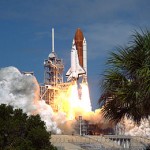 possible precautions in place.
possible precautions in place.
Besides conducting the mission’s various experiments, crew members practiced suiting up in new partial-pressure “launch-and-entry” flight suits, and also practiced the unstowing and attaching of the new crew escape system. On 2 October, the day before the mission ended, the five man crew paid tribute to the seven crew members lost in the Challenger disaster. Discovery landed on Runway 17 at Edwards Air Force Base, California, at 12:37 pm EDT on 3 October 1988, after a mission duration of four days, one hour and eleven seconds. Capsule Communicator Blaine Hammond Jr welcomed the crew, saying it was “a great ending to a new beginning.”
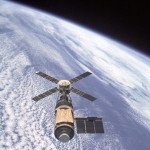 When most of us think of a space station, we think of the International Space Station that exists today, but in reality, that is not the first space station that ever floated above our atmosphere. The first one was a small space station called Skylab 1, The idea of a space station and crew to live and work in space was one that was tossed around for years. It was finally realized and launched into space on May 14, 1973, but this was not to be a mission without any issues.
When most of us think of a space station, we think of the International Space Station that exists today, but in reality, that is not the first space station that ever floated above our atmosphere. The first one was a small space station called Skylab 1, The idea of a space station and crew to live and work in space was one that was tossed around for years. It was finally realized and launched into space on May 14, 1973, but this was not to be a mission without any issues.
Just 63 seconds into the launch, a meteoroid shield that was supposed to shelter Skylab accidentally opened. This put Skylab 1 at serious risk. Later the facility experienced communications problems with the antenna as a direct result of the launch incident. Nevertheless, as problems go, this was the least of the agency’s worries. “When the meteoroid shield ripped loose, it disturbed the mounting of workshop solar array wing No. 2 and caused it to partially deploy. The exhaust plume of the second stage retro-rockets impacted the partially deployed solar array and literally blew it into space,” NASA wrote.
NASA scrambled to stabilize the space station and take necessary measures to minimize the posibility of overheating, as well as, figuring out a way to handle its reduced power situation. The first crew, which was led by Apollo 12 commander Pete Conrad, would need to make the station habitable before they could get to work. The crew’s first job, which took place during the spacewalk, just hours after launch, was to deploy the solar array, but that didn’t work, because the metal strip holding it is place, refused to release. The crews continued to be frustrated with this and other operations problems, before finally managing to make the space station work relatively well.
Skylab spent six years orbiting Earth until its decaying orbit caused it to re-enter the atmosphere. It scattered debris over the Indian Ocean and sparsely settled areas of Western Australia. In all, three crews successfully lived on board the station for several months each. The last crew spent 84 days in orbit. This was an an American record that stood until the shuttle era.
I’m sure that, looking back on those years now, NASA must have felt like it had been living in the stone age. With the Space Shuttle and the International Space Station, going into space in earlier days was rather archaic. Of course, with the end of the Space Shuttle era, we don’t know what the face of space travel will be in the 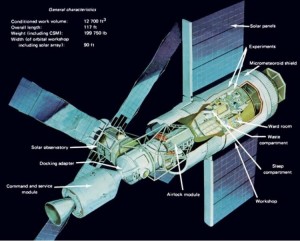 future. Only time will tell. Nevertheless, in 1973, we were well ahead of the rest of the world with the first space station, no matter how archaic it was.
future. Only time will tell. Nevertheless, in 1973, we were well ahead of the rest of the world with the first space station, no matter how archaic it was.
Because of multiple problems experienced by Skylab 1, the space station’s orbit decayed faster than expected. This was mostly due to intense solar activity heating up Earth’s atmosphere. Soon, NASA knew that it was inevitable that the space station would come down. They adjusted the station as much as possible so it wouldn’t hit populated areas upon re-entering on July 11, 1979. A slight mathmatical error led to pieces falling in Australia, but fortunately nobody was hurt, and thankfully that was not the end of the space stations.
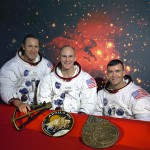 By the late 1960s, space travel had become a pretty common story for the people of the United States. NASA had enjoyed a relatively accident free space travel history, having only lost three astronauts, and that was a fire on the launch pad during training. So, when it came to Apollo 13 going to the Moon, which had been done twice before, the networks decided that it was boring, and opted not to televise the program…until disaster changed everything. For me, it seems impossible that anyone could think that space flight is boring, but someone at the top ranking position in the media, had made an executive decision, so that was the end of it.
By the late 1960s, space travel had become a pretty common story for the people of the United States. NASA had enjoyed a relatively accident free space travel history, having only lost three astronauts, and that was a fire on the launch pad during training. So, when it came to Apollo 13 going to the Moon, which had been done twice before, the networks decided that it was boring, and opted not to televise the program…until disaster changed everything. For me, it seems impossible that anyone could think that space flight is boring, but someone at the top ranking position in the media, had made an executive decision, so that was the end of it.
On April 11, 1970, Apollo 13, the third manned lunar landing mission was launched from Cape Canaveral, Florida, carrying astronauts Jim Lovell, Jack Swigert, and Fred Haise. If you’ve ever seen the movie “Apollo 13”, you will know that Jack Swigert had replaced Ken Mattingly, who had been exposed to the German measles. Ken would never get the measles, but rather was a part of the NASA team effort that worked to bring the stranded astronauts back home safely. The crew planned to land on the Fra Mauro highlands of the moon, but two days into the mission, disaster struck when oxygen tank number 2 blew up in the spacecraft, after Jack Swigert was told to preform a cryo stir procedure to the oxygen tanks…a routine maintenance procedure. Then, Swigert uttered those now famous words, “Houston, we’ve had a problem here.” After evaluation, it was determined that the normal supply of oxygen, electricity, light, and water had been disrupted. Their mission to land on the Moon was over, and now they had a new mission…survival!!
Suddenly the news media was very interested in this mission. A successful mission was boring and not news worthy at all, but one in which fatalities might occur, is very interesting. Sad really…when you think about it. The television stations were supposed to broadcast a segment the crew did about life in space, but while the crew did their segment, the stations decided not to broadcast it for lack of interest. Nine minutes later, when disaster struck, everyone was suddenly very interested. I guess I just don’t understand why we would rather watch news about a disaster, than a successful space mission. I don’t think there is anything common about space travel, and yet, it goes on a lot in our world, completely without notice.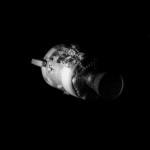
Once the disaster began, the world watched anxiously, praying for the safe return of these brave men. The broken vehicle could not make the trip, and they would have to use the lunar landing module, Oddesy to get them home. They limped along, making the necessary “MacGyver” like connections and adjustments to allow them to have enough oxygen. They made “controlled burns” using the Earth as a guide. Not very controlled at all. It took tremendous effort on the parts of many people, but it all paid off, when on April 17, tragedy turned to triumph as the Apollo 13 astronauts touched down safely in the Pacific Ocean. It was a successful failure, in that no lives were lost.
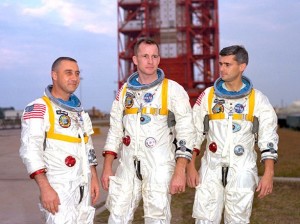
 The NASA Space Program had suffered relatively few losses during it’s many years of existence, but when something happens, it is felt around the world. Like a plane crash, it hits everyone very hard. What I find very strange is the fact that NASA’s three tragedies that brought about loss of life, while years apart, all took place within a week’s time of each other. All three of these losses were very different in how they happened. The January 27, 1967 fire on the launch pad that took the lives of Virgil “Gus” Grissom, Edward White II, Roger Chaffee in a routine ground test of the capsule that would later become Apollo 1 was a fire started by an electrical spark. The fire engulfed their high-pressurized, pure-oxygen cabin, and the astronauts suffocated. There was no emergency release on the door. They couldn’t get out. The Challenger, was lost on the 28th of January, 1986. It blew up during launch because an O-ring failed when the fuel tanks were stirred, killing all seven of the astronauts, and leaving the nation in mourning at the loss of Francis “Dick” Scobee, Ron McNair, Mike Smith, Ellison Onizuka, Judy Resnik, Greg Jarvis, and Christa McAuliffe.
The NASA Space Program had suffered relatively few losses during it’s many years of existence, but when something happens, it is felt around the world. Like a plane crash, it hits everyone very hard. What I find very strange is the fact that NASA’s three tragedies that brought about loss of life, while years apart, all took place within a week’s time of each other. All three of these losses were very different in how they happened. The January 27, 1967 fire on the launch pad that took the lives of Virgil “Gus” Grissom, Edward White II, Roger Chaffee in a routine ground test of the capsule that would later become Apollo 1 was a fire started by an electrical spark. The fire engulfed their high-pressurized, pure-oxygen cabin, and the astronauts suffocated. There was no emergency release on the door. They couldn’t get out. The Challenger, was lost on the 28th of January, 1986. It blew up during launch because an O-ring failed when the fuel tanks were stirred, killing all seven of the astronauts, and leaving the nation in mourning at the loss of Francis “Dick” Scobee, Ron McNair, Mike Smith, Ellison Onizuka, Judy Resnik, Greg Jarvis, and Christa McAuliffe.
The third NASA loss took place on February 1, 2003, and this one happened on re-entry into our atmosphere. The damage that caused the demise of the Space Shuttle Columbia happened during the launch, when a piece of foam insulation broke off and damaged the leading edge of the wing. When the shuttle re-entered the Earth’s atmosphere, the wind and heat entered the wing and blew it apart, because the heat-resistant tiles covering the left wing’s leading edge had been damaged or were missing. Pieces of the shuttle began raining down across Texas, as well as the bodies of the astronauts. This loss was very different than the others, in that is was a much less controlled situation. The prior losses could be cordoned off and kept out of the public view, but the way that Columbia was damaged, far above the Earth, causing it to rain down over such a large area, made it impossible to control, and consequently, people were coming across bodies and debris. I can’t imagine anything worse, because these were our beloved astronauts, and this was such an undignified end. It was heart wrenching for everyone in this nation. We will always remember Rick Husband, Willie McCool, Michael Anderson, Kalpana Chawla, David Brown, Laurel Clark and Israeli astronaut Ilan Ramon.
With the end of the space shuttle portion of the NASA program, the future of our nation’s work in space seems to be in question. It is hard for me to imagine going from the Space Shuttle, with the amazing ability to land like an airplane, back to a rocket. The new Orion rocket is designed to go further that any other spacecraft, and 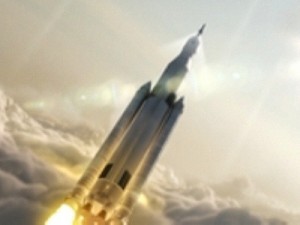
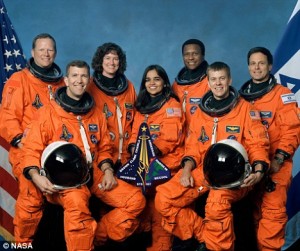 the astronauts are used to living in space for six months at a time, so the possibilities are endless, and only time will tell. With each loss come a new wisdom and increased knowledge about the things that make our astronauts unsafe, and what things can keep them safe on their journeys into the unknown. Today, however, is a day to remember NASA’s lost ones on the twelfth anniversary of the loss of the Space Shuttle Columbia.
the astronauts are used to living in space for six months at a time, so the possibilities are endless, and only time will tell. With each loss come a new wisdom and increased knowledge about the things that make our astronauts unsafe, and what things can keep them safe on their journeys into the unknown. Today, however, is a day to remember NASA’s lost ones on the twelfth anniversary of the loss of the Space Shuttle Columbia.

